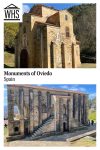Monuments of Oviedo and the Kingdom of Asturias
By Pamela Russell
What are the Monuments of Oviedo and the Kingdom of Asturias?
The Monuments of Oviedo and the Kingdom of Asturias are six structures in north central Spain, all dating to the first part of the ninth century (about 800-850 AD). They were all built under royal patronage, when the region of Asturias was ruled by a dynasty of Christian kings. Asturias is often considered the cradle of modern Spain because of this Christian kingdom that remained independent at the time of Muslim rule in the rest of the Iberian peninsula.
Disclosure: This article contains affiliate links. Making a purchase through an affiliate link will mean a small commission for this website. This will not affect your price.
Oviedo, the modern-day capital of the autonomous community of Asturias, was the seat of the court of King Alfonso II (who ruled 791-842, a contemporary of Charlemagne), the eighth king of the dynasty. Alfonso II and his successor, Ramiro I (who ruled 842-850) were responsible for building these surviving monuments.
There are three churches, a royal chapel, a palace and a fountain house in this UNESCO designation:
- San Julian de los Prados: This is a functioning church in Oviedo with remarkable interior murals.
- San Miguel de Lillo: Once a church, San Miguel de Lillo is now a historic landmark, on a hill overlooking Oviedo.
- Santa Cristina de Lena: This former church is 22 miles south of Oviedo.
- Cámara Santa: A royal chapel that is now part of the cathedral of Oviedo and a treasury for holy relics.
- Santa Maria del Naranco: This was originally a rural palace of Ramiro I and became a church in the tenth century. It’s now a historic landmark, on a hill overlooking Oviedo.
- La Foncalada: This is a fountain house in Oviedo.

Today the Cámara Santa, San Julian de los Prados and the Foncalada are within the city of Oviedo, although the last two originally lay outside the walled city of Alfonso II. San Miguel de Lillo and Santa Maria del Naranco lie next to each other on a hill overlooking the city. Santa Cristina de Lena is the outlier, located in the hills 22 miles south of Oviedo.
The most impressive architecturally are the churches of San Julian de los Prados and San Miguel de Lillo, as well as Santa Maria del Naranco, the summer palace of Alfonso II.
The Cámara Santa, within the Cathedral of Oviedo, has been of great significance to the faithful since its origin. Today it continues to house some of the most important treasures and relics of the cathedral.
The more remote Santa Cristina de Lena is also important for its unusual floor plan and attractive colonnaded interior with a decorative, possibly Visigothic, altar screen.
Why are the Monuments of Oviedo a UNESCO World Heritage site?
The six monuments designated as a UNESCO World Heritage site are considered the jewels in the crown of the distinctive architectural style of the Asturian monarchy, which lasted from 718 to 910. Buildings surviving from this period are rare in Europe.
This architectural group documents an important period in Spanish history and is testament to the creative innovations of the artists working in the Asturian royal courts. The buildings’ key stylistic elements include tall, narrow proportions with external support pilasters; brick arches rising from columns to form windows and porticoes; window screens with delicate stone tracery; carved decorative ornament in low relief; and, only rarely preserved, colorful interior wall paintings.
As noted on their UNESCO World Heritage page, these monuments represent “a unique artistic achievement which is neither a metamorphosis of Paleo-Christian art nor a feature of Carolingian art.”
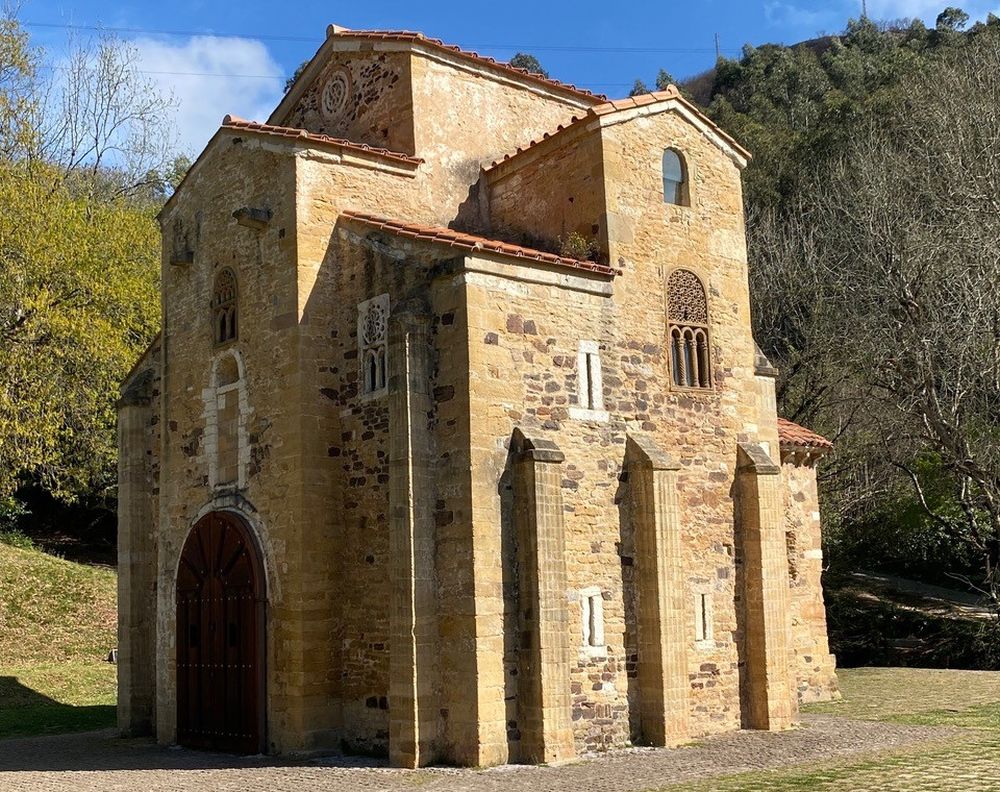
What can you expect from a visit to the Monuments of Oviedo?
None of these monuments are ever very crowded with visitors, and all but Santa Cristina de Lena are easy to visit in Oviedo. Oviedo is an attractive, moderately-sized city (pop. 220,000). It has a rich cultural heritage, a lively arts scene, a lovely central park, and innumerable restaurants and cafes serving delicious food and refreshments. Local specialties are fabada (a savory bean stew), cachopo (breaded veal stuffed with cured ham and cheese), strong blue cheeses, and hard cider: a crisp, tart drink made from local apples.
Although some of the monuments are more easily reached than others, all offer a fascinating picture of a long-lost ancient kingdom. The easiest to visit, the Cámara Santa, the royal chapel of Alfonso II, is probably the least impressive architecturally, but the relics it houses are dazzling. They include the ninth-century “Cross of the Angels” made of gold and inlaid with jewels, the tenth-century “Victory Cross” made of the same materials, a large box inlaid with agate, and other treasures. The room itself was remodeled in the twelfth century, when a magnificent series of columns with carved shafts representing the twelve apostles was added. They are considered masterworks of the Spanish Romanesque.
The astonishingly well-preserved mural paintings in the interior of San Julian de los Prados are perhaps the most spectacular of all the monuments. They depict intricate scenes of buildings and curtained alcoves, as well as an abundance of intricate geometric patterns. Some scholars connect the decorative scheme with much earlier Roman wall-painting. They suggest the murals have more in common with secular, palatial traditions than Christian ones. Curiously, there are no human figures, although human figures do appear in the poorly-preserved mural fragments at San Miguel de Lillo.
Book your accommodations in Oviedo here.
The two structures on Monte Naranco overlooking the city, Santa Maria del Naranco and San Miguel de Lillo, are beautifully situated and make for a pleasant outing. Much can be appreciated just from their interesting exteriors, even if the timing isn’t right for a guided tour of the interiors.
The unusual and beautiful church of Santa Cristina de Lena is located in an out-of-the-way spot about a half hour outside of Oviedo. The architectural plan is unusual, having a single wide aisle, rather than the normal three, and graceful marble columns and arches. It also has interesting relief carvings on the inside, most notably a lovely altar screen with plant and geometric ornaments. There is also a dedicatory Visigothic inscription dating from the seventh century, indicating the reliefs were re-used from an earlier structure.
While particularly interesting on the inside, a visit to Santa Cristina de Lena is probably most valuable to those with a deeper interest in Asturian architecture, or those with a fondness for country walks, since a visit could be combined with a day or half-day of hiking.
Are the Monuments of Oviedo worth visiting?
Even if you are only spending one day in the Asturian capital, a visit to the cathedral and the Cámara Santa should be on your list. In second place is San Julian de los Prados, if you can arrange an appointment. Its wall paintings are breathtaking, especially considering their ninth-century date.
If you have more time, it is well worth a trip up Mount Naranco to see the two structures there and to admire the views of the city. Perhaps only dedicated art history buffs need to book the tours of the interiors of these two buildings – the external vistas are rewarding enough.
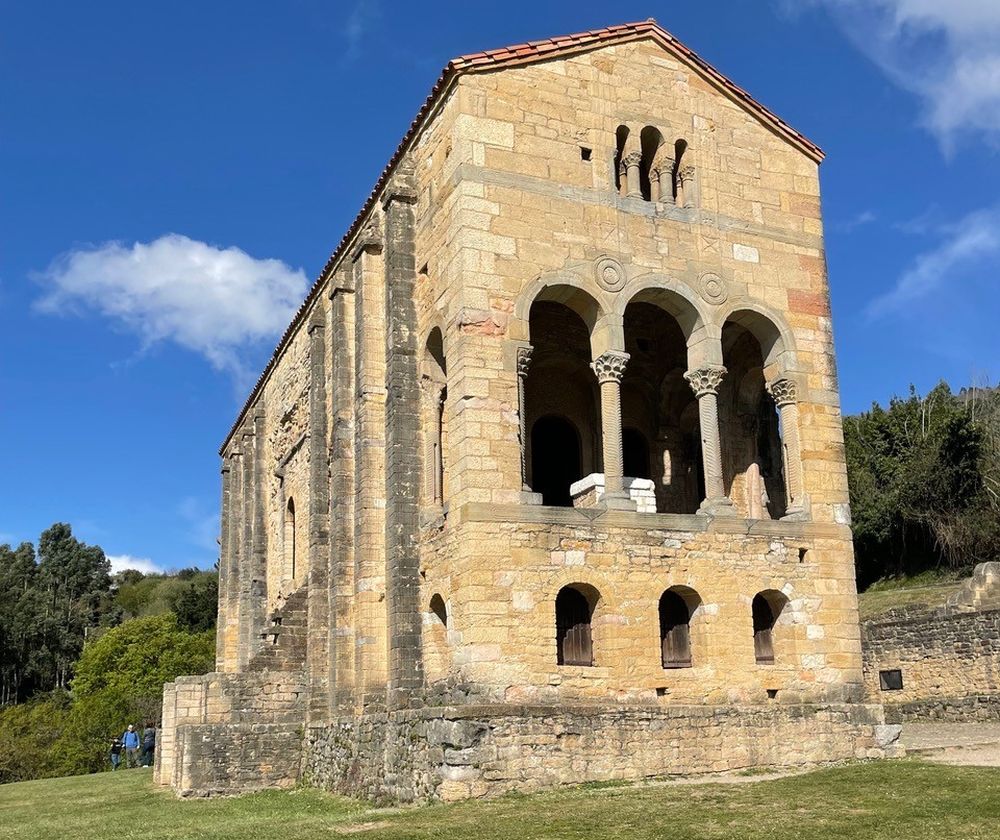
Lower on the list might be the fountain house. Yet you may see it almost by accident if you enjoy a night of cider on the lively Calle Gascona. Those with plentiful time, access to a private car, and a love of either the architecture of this period or of the beautiful Asturian countryside will be the ones who make the short road trip to Santa Cristina de Lena.
What sorts of travelers would like the Monuments of Oviedo?
These fascinating – but not spectacular in the sense of grand scale or opulent materials – monuments will most appeal to history and art history buffs and those who like to explore lesser-known places. They represent a unique phase in the history of Spain and demonstrate the innovative spirit of a relatively remote corner of the European orbit. While many travelers flock to the great Romanesque and Gothic churches of Europe – places like Burgos Cathedral – fewer are familiar with this intriguing earlier stage, between the Roman and Medieval periods. The exceptionally well-preserved buildings that survive in Asturias provide the opportunity to immerse yourself in a long-gone, yet once illustrious kingdom.
Tips for visiting the Monuments of Oviedo
Although the monuments form an architecturally cohesive group, access to them differs.
For all of these monuments, visiting times and admission prices change frequently. Please check the websites and, preferably, call ahead to get the latest information. Since some are functioning churches, worship times and holidays need to be noted as well.
Cámara Santa
The Cámara Santa is located inside the impressive Gothic cathedral of Oviedo, in the heart of the old city, surrounded by cafes, restaurants, and shops. You can easily visit it as part of the tourist visit to the Oviedo cathedral. Broad stairs lead to the chamber. It is not accessible by wheelchair.
A second flight of stairs leads to the interesting cathedral museum, whose displays are arranged around the cloister. Visits to the imposing cathedral tower (with separate ticket) have been allowed since 2022.
During certain religious holidays (for example, Saint Matthew’s festival on September 14-21), some of the relics kept in the chamber may be removed for use on the high altar.
Tickets are purchased on site at the time of visit. There are public bathrooms in the lower cloister. The cathedral is located within a pedestrian zone, a short walk from the nearest bus stops and parking garages. The closest parking is at a public underground garage, Parking Escandalera (fee), 0.2 miles away, a 5-10 minute walk from the cathedral.
Address: Plaza de Alfonso I in Oviedo.
For more information about the Cámara Santa and the cathedral, their opening hours and admission fees, see their website.
San Julian de los Prados (sometimes shortened to “Santullano”)
The Oviedo church of San Julian de los Prados is easy to get to but a visit to the inside requires an advance reservation.
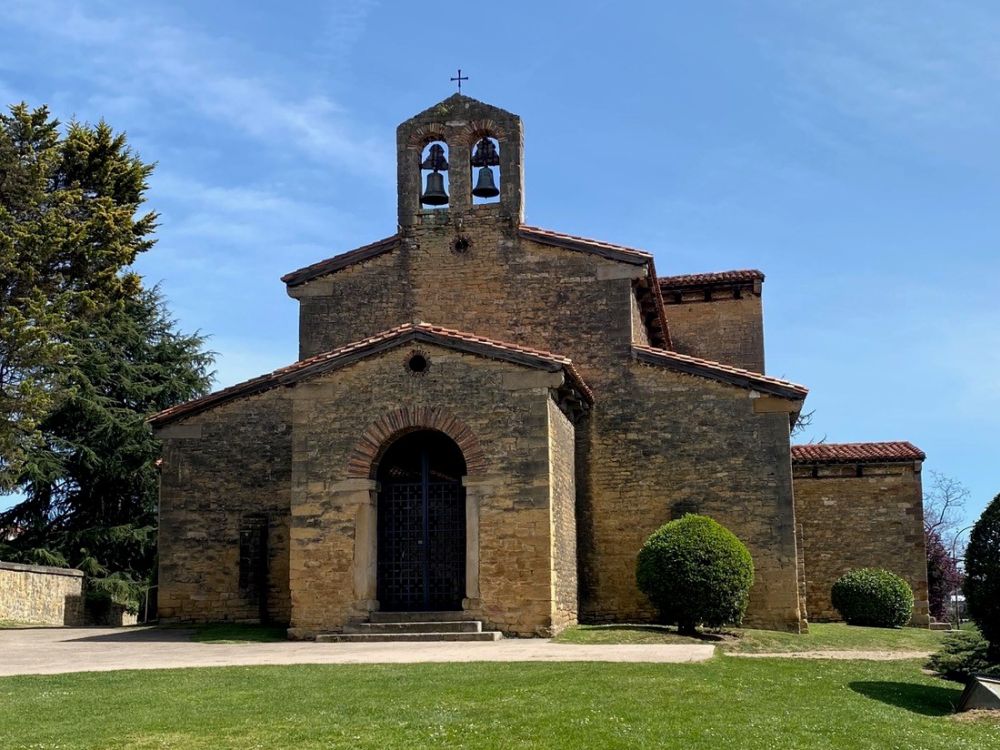
This gem of a church is located in a pleasant, expansive park, not far from one of the campuses of the University of Oviedo. It is still a fully operational parish church, not a museum, so visitors should respect worship times and other church activities.
The interior paintings may only be seen at set times on 30-minute guided tours. The website shows tour times, but confirmation through an email or phone call to the guide will assure a tour is available. Tours are offered in Spanish only, but visits to the interior are well worth it in any case.
Street parking may be available; parking garages are located a 10-minute walk away. Nearby bus stop on the E line (See tua.es for local transportation information).
Address: Calle Selgas, 2 in Oviedo.
For more information about San Julian de los Prados, its opening hours and admission fees, see its website.
La Foncalada
The fountain house, La Foncalada, located at a city intersection, is best visited on foot. It is at the foot of the popular Calle Gascona, home to some of the best cider houses, or sidrerias, in town. You might want to avoid visits to the fountain house late at night or weekend afternoons – unless you want to be part of a festive scene!
Located at the meeting of Calle Foncalada and Calle Gascona (a pedestrian street) in central Oviedo. Open access all the time. There is an information sign at the site. Nearby bus stops on the B, D, and E lines.
Address: Calle Foncalada in Oviedo.
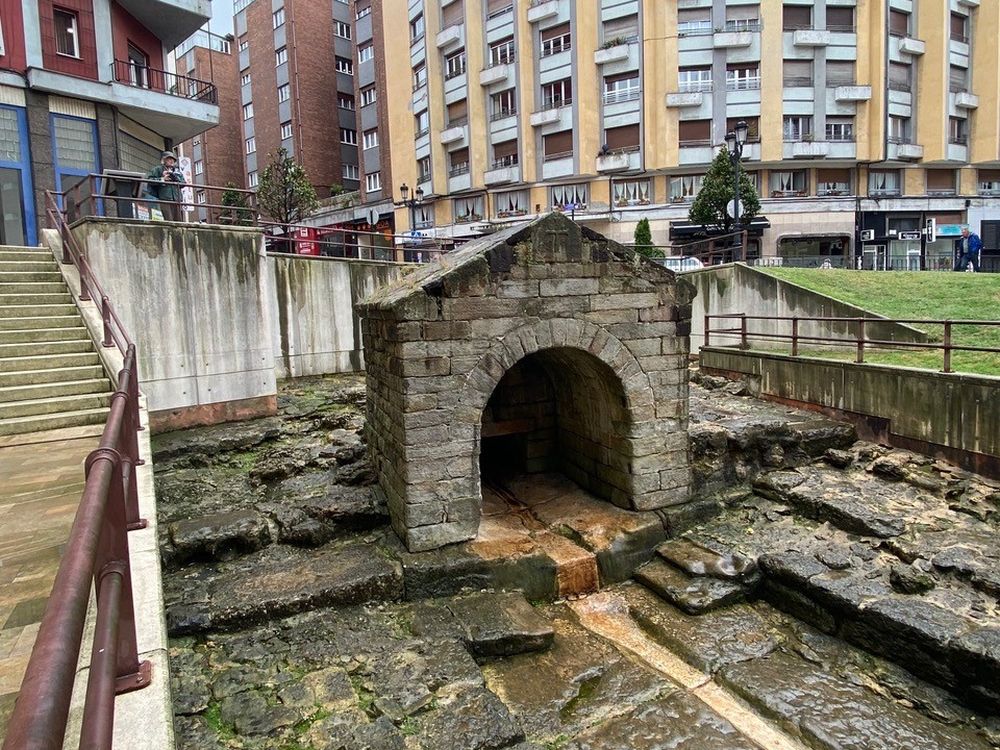
This walking tour includes the Cathedral (with the Cámara Santa) and La Foncalada, along with other city sights.
Santa María del Naranco and San Miguel de Lillo
The structures overlooking Oviedo – Santa Maria del Naranco and San Miguel de Lillo – can be reached by public transportation or car, followed by a bit of a climb on foot. The interiors of both can be visited only through a scheduled guided tour.
These two monuments are best visited together. They are located partway up a hill that overlooks the city of Oviedo, Mount Naranco. Naranco is a favorite spot for walking (the Finnish Track, or Pista Finlandesa is most popular). Both tourists and natives of Oviedo walk up to the churches from the city. At the top of the hill there is a modern (1980) monumental statue of Christ and the best views of the city.
Near the monuments is a little interpretation center that provides historical and architectural context for the buildings. There are no cafes in the immediate vicinity of the monuments.
There is a parking lot located below the monuments, requiring a short, but uphill walk to reach them. Visitors reach the interpretation center, with public bathrooms, before the monuments themselves. Tickets for guided visits to see the interiors are available at the lower level of Santa Maria del Naranco (not the interpretation center, which is free). Guided tours last about 30 minutes. Entry is free on Monday mornings and is without a guide.

Bus line A from Oviedo stops at the parking lot below the monuments.
Address: Monte Naranco in Oviedo.
For more information about these two monuments, their opening hours and admission fees, see Santa Maria del Naranco’s website or the website for the interpretation center. This website also offers information on all structures of the Asturian kingdom, under the tab “Monuments.”
Santa Cristina de Lena
The church of Santa Cristina de Lena 22 miles (35 km) south of Oviedo is in a rather remote spot, near the village of Palacio. It is best to visit this hilltop church by private car. It is directly on the way to Leon, if you happen to be traveling in that direction.
You can always try a spontaneous visit during the posted opening hours, but advance confirmation by telephone is recommended if you want to guarantee a chance to get in.
The church is about a half hour’s drive south of Oviedo via the A-66 highway (Pola de Lena exit). In the vicinity of the church is a very small parking lot (near the locality of Vega del Rey). From there, walk uphill about 250 yards on a steep cobbled path (130’ elevation gain) to reach the church. Alternatively, for a longer (0.4 mile), but flatter approach on foot, you can park in a parking area off the road just west of the village of Palacio.
Visiting hours are posted on the website. However, calling ahead is a good idea, since the spot is remote and opening times are subject to change.
Other UNESCO sites are also reachable as day trips: several elements of the Routes of Santiago de Compostela and some of the caves that make up the Paleolithic Cave Art site.
Have you been to Oviedo? If so, do you have any additional information or advice about this UNESCO World Heritage site? Please add your comments below!

